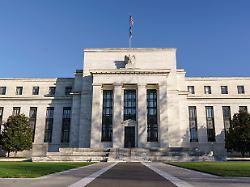Inflation rate is already falling
Fed raises interest rate and hints at pause
5/3/2023 8:03 p.m
Irrespective of the banking turbulence it helped to trigger, the US central bankers are again raising the key interest rate. This means that the level that the Fed had forecast for the end of the year has been reached. A change in the accompanying text suggests that the Fed now wants to monitor the consequences of its policy.
In its fight against high inflation, the US Federal Reserve has raised interest rates for the tenth time in a row. The Fed did not let the most recent bank collapse in the USA – the collapse of the First Republic Bank – slow it down. Now, however, an interest rate pause could follow. With another jump in interest rates of 0.25 points, the key interest rate is now in the range of 5.0 to 5.25 percent, as announced by the Federal Reserve. This is the highest value since 2007 – i.e. before the start of the global financial crisis. The European Central Bank will announce its interest rate decision tomorrow, Thursday. Here, too, experts expect an increase of 0.25 points.
After the rapid increase, the end of the road is likely to have been reached for the time being: the monetary watchdogs deleted a passage from their text, according to which a certain additional tightening of monetary policy could be appropriate. Instead, a wording was chosen that leaves the door open for a possible tightening, but gives no signal for it.
For Bastian Hepperle from Hauck Aufhäuser Lampe, “the key interest rate peak has probably been reached”. The time to wait and a longer break in interest rates has come. For LBBW, too, there is much to suggest “that the Fed’s tenth interest rate hike in a row was their last for the time being.” There were increasing signs that economic activity would be slowed down. The unresolved dispute over the US budget also speaks in favor of waiting. For the ZEW, the banking crisis and the debt dispute are even helping the Fed in the fight against inflation – which is why an interest rate pause is the right thing to do. Because more cautious lending by the banks and possibly lower government spending also slowed down inflation.
pace like it hasn’t in decades
The Fed had to balance its decision between calming concerns in the banking sector and fighting high consumer prices. In the past year, the Fed had raised interest rates by an impressive 0.75 percentage points several times. The central bank had thus set a pace that it had not seen in decades. She initiated this turnaround in interest rates a good year ago – at that time the key interest rate was almost zero.
Recently, however, the Fed has opted for smaller rate hikes. According to the forecast published in March, decision-makers at the Fed expect the key interest rate to average 5.1 percent at the end of the year. This value has been reached with the current increase.
The Fed’s aggressive rate hikes have also triggered some of the turmoil in the banking sector. The collapsed banks did not adequately protect themselves against rising interest rates. These have, for example, reduced the market value of their securities holdings. With the First Republic Bank, another struggling US money house has just collapsed.
Inflation rate falling – labor market robust
At the same time, consumer prices in the US are still too high. Keeping inflation in check is the traditional task of central banks. If interest rates rise, private individuals and the economy have to spend more money on loans – or borrow less money. Growth is slowing, companies cannot simply pass on higher prices – and ideally the inflation rate is falling. At the same time, there is a risk that the economy will stall. The high level of inflation in the USA had recently weakened more than expected. In March, consumer prices rose by five percent on a yearly basis. But that figure is still a long way off the Fed’s target inflation rate of 2 percent on average.
At the same time, the labor market remains robust. What actually sounds good, however, can drive up consumer prices even further. Because a strong labor market is generally seen as a driver for wages and thus for inflation. The recent turmoil in the banking sector could have a similar effect as interest rate hikes and dampen demand due to more cautious lending. Fed Chair Jerome Powell also relied on this recently.
